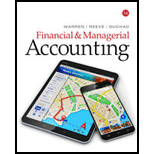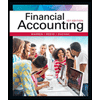
A.
Statement of
Direct method: The direct method uses the cash basis of accounting for the preparation of the statement of cash flows. It takes into account those revenues and expenses for which cash is either received or paid.
Cash flows from operating activities: Cash flows from operating activity represent the net cash flows from the general operation of the business by comparing the cash receipt and cash payments.
Cash Receipts: It encompasses all the cash receipts from sale of goods and on account receivable.
Cash Payments: It encompasses all the cash payments that are made to suppliers of goods and all expenses that are paid.
The below table shows the way of calculation of cash flows from operating activities:
| Cash flows from operating activities (Direct method) |
| Add: Cash receipts. |
| Cash receipt from customer |
| Less: Cash payments: |
| To supplier |
| For operating expenses |
| Income tax expenses |
| Net cash provided from or used by operating activities |
To Determine: The amount of cash received from customers.
B.
The amount of cash payments for income taxes.
C.
To Explain: Why the cash received from customers is different from sales.
Want to see the full answer?
Check out a sample textbook solution
Chapter 13 Solutions
Financial and Managerial Accounting - With CengageNow
- Olivia Production calculates its overhead budget based on budgeted machine-hours. The production schedule indicates that 12,400 machine-hours will be required in November. The variable overhead rate is $8.50 per machine-hour. The company's budgeted fixed manufacturing overhead is $186,000 per month, which includes depreciation of $43,000. All other fixed manufacturing overhead costs represent current cash flows. The company recomputes its predetermined overhead rate every month. What should be Olivia Production's predetermined overhead rate for November? A. $23.50 B. $18.90 C. $21.26 D. $16.00arrow_forwardI want the correct answer with accountingarrow_forwardWhat is the value of ending inventory assuming the use of direct costing ?arrow_forward
- general accountingarrow_forwardSkynet Corporation estimates that its employees will utilize 225,000machine hours during the coming year. Total overhead costs are estimated to be $5,625,000 and direct labor hours are estimated to be 150,000. Actual machinehours are 210,000. Actual labor hours are 140,000. If Skynet Corporation allocates overhead based on machine hours, what is the predeterminedmanufacturing overhead rate?arrow_forwardPlease explain the solution to this general accounting problem with accurate explanations.arrow_forward
 Managerial AccountingAccountingISBN:9781337912020Author:Carl Warren, Ph.d. Cma William B. TaylerPublisher:South-Western College Pub
Managerial AccountingAccountingISBN:9781337912020Author:Carl Warren, Ph.d. Cma William B. TaylerPublisher:South-Western College Pub Financial Accounting: The Impact on Decision Make...AccountingISBN:9781305654174Author:Gary A. Porter, Curtis L. NortonPublisher:Cengage Learning
Financial Accounting: The Impact on Decision Make...AccountingISBN:9781305654174Author:Gary A. Porter, Curtis L. NortonPublisher:Cengage Learning Financial AccountingAccountingISBN:9781337272124Author:Carl Warren, James M. Reeve, Jonathan DuchacPublisher:Cengage Learning
Financial AccountingAccountingISBN:9781337272124Author:Carl Warren, James M. Reeve, Jonathan DuchacPublisher:Cengage Learning College Accounting, Chapters 1-27AccountingISBN:9781337794756Author:HEINTZ, James A.Publisher:Cengage Learning,
College Accounting, Chapters 1-27AccountingISBN:9781337794756Author:HEINTZ, James A.Publisher:Cengage Learning, Financial And Managerial AccountingAccountingISBN:9781337902663Author:WARREN, Carl S.Publisher:Cengage Learning,
Financial And Managerial AccountingAccountingISBN:9781337902663Author:WARREN, Carl S.Publisher:Cengage Learning,





